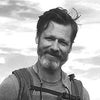Tinker Juarez probably wouldnÔÇÖt be a very good accountant. Or salesman.╠řOr really any kind of desk jockey. And he knows that. The 58-year-old mountain-biking legend╠řhas been riding╠řsince he was 13, and while he doesnÔÇÖt regret╠řhis life choices, occasionally he thinks about other avenues when heÔÇÖs on his bike, passing people commuting to work. ÔÇťI donÔÇÖt know what IÔÇÖd be doing if I wasnÔÇÖt riding,ÔÇŁ he says. ÔÇťI canÔÇÖt see myself sitting in any kind of building all day. Maybe IÔÇÖd be a gardener and mow lawns. I know IÔÇÖd work hard at it though.ÔÇŁ
ItÔÇÖs JuarezÔÇÖs dedication that has helped him become an icon in the mountain-bike world. Born David Juarez (his family gave him the nickname Tinker), the╠řAngeleno started his career as a BMX racer,╠řbecoming one of the early superstars of the sport in the 1970s. After 15 years racing BMX and riding freestyle, he switched to mountain biking╠řin 1986 and began to rack up╠řa long list of accomplishments, including╠řmultiple national championships, two appearances at the Olympics, and countless single-race wins. Now, after╠řmore than three decades as a professional mountain biker, heÔÇÖs still╠řsalaried╠řwith Cannondale, his bike sponsor since 1994, and racing╠řat the elite pro level most weekends of the season. ÔÇťMy job is riding my bike, and I still have to go to work for eight hours every day, just like you,ÔÇŁ Juarez says. ÔÇťEvery year when my contract is up, I donÔÇÖt know if IÔÇÖm gonna get another one. I try to train hard every year and try to keep the racing lively and stay busy.ÔÇŁ
Juarez was an early adopter of BMXÔÇöwhen he was just a teen, he and his friends claimed a dirt mound on a vacant lot in their neighborhood in East Los Angeles, using shovels to build jumps and berms. They put fenders and mud flaps on their single-speed Schwinn bikes to make them look like motorcycles. Even then, Juarez had a stellar work ethic, riding his BMX daily, hitting jump after jump for hours after school. ÔÇťItÔÇÖs just practice,ÔÇŁ Juarez says. ÔÇťLike anything else, you have to dedicate yourself to it. For me, BMX was about constant repetition.ÔÇŁ
ÔÇťMy job is riding my bike, and I still have to go to work for eight hours every day, just like you.ÔÇŁ
JuarezÔÇÖs hard work led him to podium finishes, sponsorships,╠řand the honor of being dubbed King of the Skateparks by Bicycle Motocross Action magazine in 1980. But unlike many BMX riders, he was also into the endurance side of the sport and would cycle╠řfrom his house╠řfor several miles to hit different parks throughout the city. Eventually, Juarez says, he felt like ÔÇťthe old man at the gatesÔÇŁ at BMX competitions, so he started looking for a new challenge. His knack for pedaling╠řserved him well when he transitioned out of that type of cycling╠řand into mountain biking╠řin the mid-eighties, soon becoming a star in the╠řburgeoning╠řsport.
ÔÇťAfter 15 years of riding bikes with just one gear, it felt really good to have six gears on a mountain bike to choose from,ÔÇŁ Juarez says. ÔÇťAnd the technology in mountain biking was growing so fast. I look back and canÔÇÖt believe what I was riding in 1990 compared to what I ride today. I donÔÇÖt think I could ever go back to racing a 26-inch wheel again.ÔÇŁ
Juarez spent decades at the top of the mountain-bike world, carving out a niche for himself in nearly masochistic╠řendurance events. He╠řowned the 24-hour solo mountain-bike category in the early 2000s, winning dozens of grueling overnight races and╠řconsecutive 24-hour solo national championships from 2001 to 2004.
More than 19 years after being inducted into the Mountain Bike Hall of FameÔÇöan honor that typically comes after an athleteÔÇÖs career is overÔÇöJuarez is still competitive in endurance events: he won╠řthe Maah Daah Hey 100 in the North Dakota Badlands╠řin 2018╠řand topped╠řthe podium at the╠řUCI Masters Mountain Bike World Championship╠řin Quebec in 2019.
Juarez credits his late-career success to his consistent training schedule, which has him riding daily, tackling╠řat least 300 miles and 20,000 feet of elevation each week. He also typically puts in three long, 70-plus-mile rides a week on his road bike in the mountains outside╠řL.A. Other days will see╠řhim doing hill repeats behind his house. ÔÇťIÔÇÖm always pushing hard,ÔÇŁ Juarez says. ÔÇťI always know that each day could be my last chance to ride, so I donÔÇÖt want to cut myself short.ÔÇŁ
This year, JuarezÔÇÖs schedule is as busy as ever. Beginning in the spring, heÔÇÖll compete every weekend, mostly in the pro division, and will try to defend his UCI masters world championship in France this summer. He has races scheduled in Australia and Portugal, and heÔÇÖs started dabbling in gravel events, which he says suits his natural climbing ability. At 58, Juarez says he still feels greatÔÇöas long as he gets enough sleep. The only time he feels his age is when he has to travel to an international event:╠řthe time change, loss of sleep, and routine disruption wreak havoc on his╠řperformance.╠řÔÇťIf I canÔÇÖt sleep, IÔÇÖm screwed,ÔÇŁ Juarez says. ÔÇťRacing for eight hours after being up all night? You canÔÇÖt have a bad night and race guys half your age.ÔÇŁ Juarez combats shifts in his schedule by showing up to international events several days beforehand to give his body time to adjust.
Jet lag aside, Juarez feels great and sees no end╠řin sight for╠řhis professional mountain-bike career. ÔÇťI guess riding your bike is good for your health,ÔÇŁ he says. ÔÇťIÔÇÖm still riding hard races, and the only guys ahead of me are half my age. But IÔÇÖm always trying to win.ÔÇŁ


